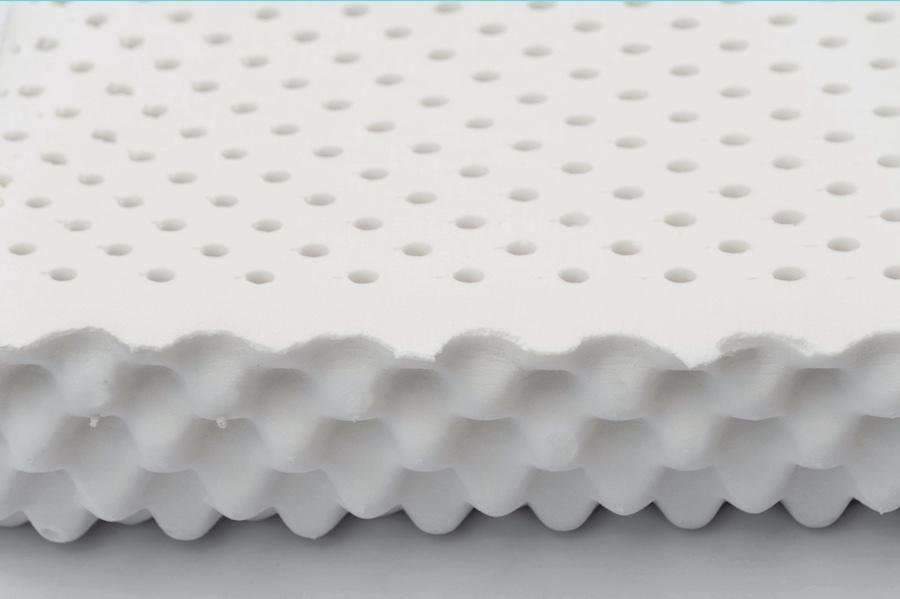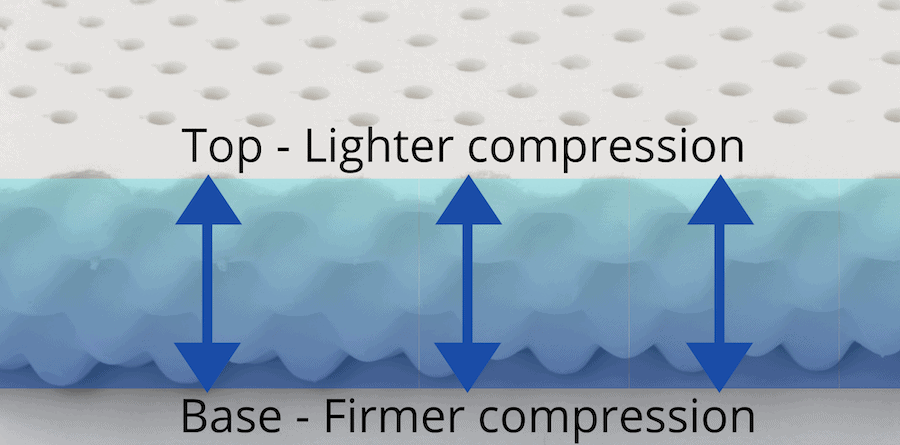So what is Latex Foam? We’ve probably all heard of Latex, and there may well be latex in your mattress at home. Here’s where I go into detail about exactly what Latex foam is, its invention, its uses in the mattress and pillow industry, the advantages, disadvantages, comparison, and more.
Latex foam is a rubber compound widely used in mattresses. Sourced from the rubber tree Hevea Brasiliensis and manufactured using two methods. The Dunlop method involves pouring into a mold. The Talalay method has additional steps and ingredients, and vacuum techniques to produce a less dense foam.
Latex rubber has been refined and is now widely used in the production of mattresses, pillows, and seating components due to its comfortable, firm, and durable properties.
Who invented Latex foam?
Latex foam was produced in 1929 by Dunlop Rubber – with patents in Britain, France, and the USA. The Dunlop name is now synonymous with many rubber based products.
Dunlop experimented with the compound to make a perfect variety of foam for use with pillows and mattresses that catered to the needs of a growing market requiring more comfortable bedding.
Latex is now heavily used in the production of mattresses and pillows. A latex mattress is usually combined with either reflex, memory foam, or springs and other layers, in order to create a more supportive, durable, and comfortable sleeping surface for the user.

How latex foam is made
Latex being a natural product is often combined with fillings made of other natural materials in order to create the perfect blend.
It is created by collecting sap from rubber trees that can keep on producing it for up to 30 years. The substance is also sometimes referred to as “rubber serum” or “white milk”.
The process of turning mere sap into latex consists of whipping the serum until it becomes frothy and then baking it.
After layers of latex have been produced comes the procedure of turning it into the right material base for mattresses and pillows. This can be done through the following two methods:
Dunlop method
This process comprises pouring the latex into a mold. For the consistency to be perfect, it is essential that it’s added in one single and continuous pour to result in a firm base but that softens towards the top.
Dunlopillo Diamond and Dunlopillo Millennium mattresses are among the most well-known mattresses produced using this method.

Talalay method
Compared to the Dunlop method, this method is a bit more complex and uses more steps in the processing and more ingredients.
In essence, the main difference in the process from the Dunlop method is to partially pour the latex into a mold and then use a vacuum process to expand it. By adopting this method, a mattress made this way has a consistent texture and firmness to it throughout its form.
Let’s go through some of the major pros and cons of Latex foam, and compare them with other foam products on the market.
Pros of latex foam
Latex foams are customizable, this is beneficial when customers can’t find the right mattress.
Latex foam mattresses can be made to cater to the different needs of each individual, they can range from more firm through to soft – according to their needs.
Latex foam also benefits customers economically, medically, and even comfort-wise. Below are some of the few advantages of owning latex foam over other types of foam for bedding purposes…
Long-lasting
Latex mattresses can be on the pricier side when compared to other conventional options.
However, due to their natural resilience and ability to maintain their shape – along with durability and performance, they can last for up to 20m years – almost twice …or sometimes three times as long as other mattresses. A latex-based mattress is an all-around good investment.
You will be able to tell when your Latex foam is starting to deteriorate and require replacing when it begins to crumble. Typically along exposed edges or in heavy use areas.
Pressure relief
The elastic and properties found within latex enable the mattress to quickly and evenly adapt to the user’s weight and shape of the user, as well as their movements.
This further helps support the user’s heaviest parts of the body – resulting in greater pressure relief.
People with back problems can highly benefit from this mattress as it provides appropriate support to the spine.
Easy maintenance
With many types of mattresses, there is a need to flip the mattress over or turn it to prevent it from losing its shape. This is often required every 6 months or so in order to help maintain a good night’s sleep.
But since latex mattresses are created as a single-sided component, and are more durable when it comes to maintaining their shape and form, customers don’t have to worry about flipping them over.
Latex foam is hypoallergenic
For people with dust mite allergies, latex mattresses are a natural remedy. The reason behind this is that the latex structure is naturally very resistant to dust-mites.
This helps in not only saving the user from an unwanted dust mite infestation but also providing a comfortable, healthy, and fresh environment to sleep in.
Latex foam is eco-friendly
In today’s world, people are more awake and conscious of the rapidly deteriorating eco-environment.
Latex mattresses are a major advantage in this area as they’re one of the most eco-friendly foams available on the market.
The rubber tree is estimated to negate around 90 million tons of carbon dioxide which is converted into oxygen by the rubber trees that are used for harvesting the latex sap. They also require lower use of fertilizers and create less biodegradable litter.

Cons of latex foam
Latex foam does have its disadvantages however, here’s where we go through a few of them…
Heat
When buying latex foam it is necessary to keep in mind that these mattresses are generally on the hotter side which can be an inconvenience for some people.
However, this issue can easily be avoided by making sure that any covers that you use are breathable and clean, preferably made up of wool or natural cotton, as these materials allow appropriate air-flow.
Heavy
High-quality latex foams are quite heavy to lift and move around, especially alone. However, most mattresses are heavy to lift alone anyway, so why not have them be heavy but of good quality rather than just heavy.
The weight of mattresses is also dependent on the density and size, so with proper research, appropriate decisions can be made.
The fact that the reason for moving around mattresses doesn’t normally frequently occur, especially with latex foams that don’t need to be flipped from time to time, should be kept in mind.
Compression
Another problem experienced by latex foam users is that these mattresses are prone to impressions and imprints.
Meaning, if a person is a heavy sleeper with minimal movements, the shape of your body can leave an imprint in the mattress.
This issue is most commonly experienced among people who sleep with their partners and have designated spots on the bed.
However, this doesn’t mean that the comfort or support of a latex mattress is compromised, it merely proves to be an inconvenience as it can limit a person’s natural movements.
Costly
The biggest con of latex foam is its higher price range, making customers hesitant to opt for it.
This is due to the cost of manufacturing it which has an impact on the end price. But since it has tremendous durability rates, buying these mattresses can be seen as an investment over the course of its lifetime.
Transfer of motion
One more downfall of latex foams is that even though it provides a good separating motion from one side to the other, compared to other available options such as the memory foam, it is not as good.
Due to its natural bouncy feel, vibrations can be felt from one side of the mattress to the other side. This can be a minor annoyance for people who are light-sleepers and have partners.
Here’s a summary table outlining the benefits of Latex foam when compared to other foams on the market…
| Foam Type | Latex | Memory | Polyurethane |
|---|---|---|---|
| Materials/Chemicals | |||
| Rubber tree sap | Yes | No | No |
| Formaldehyde | No | Yes | Yes |
| Petroleum derivatives | No | Yes | Yes |
| Flame retardant | No | Yes | Yes |
| Antioxident | Yes | No | No |
| Performance | |||
| Life span | <=20 years | <=10 years | <=10 years |
| Shape return | Instant | 1 Minute | Instant |
| Long term shape retention | Excellent | Fading | Good |
| Density (Ib per cubic feet) | |||
| Low density (PCF) | < 4.3 | < 3 | < 1.5 |
| Medium density (PCF) | Avg. 4.8 | Avg. 4 | Avg 1.6 |
| High Density (PCF) | > 5.3 | > 5 | > 1.7 |
| Comfort | |||
| Temperature balance | Excellent | Poor/Medium | Poor/Medium |
| Relief of pressure | Very good | Excellent | Medium/Fair |
| Weight/body support | Excellent | Medium/Fair | Good |
| Motion Transfer | Medium/Fair | Low/minimal | Medium/Fair |
| Breathability | Good | Medium/Fair | Medium/Fair |
To finish
I hope this has provided you with a good grounding with regards to “what is latex foam”. Be sure to check out my other articles and recommended foam products to find what fits your needs.
